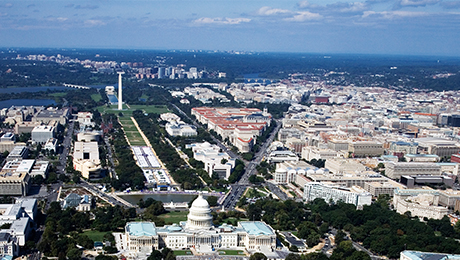By James Irwin
Students and faculty at the George Washington University are assisting city officials and nonprofit and business community leaders to help make D.C. more age-friendly—one city block at a time.
As part of D.C.’s age-friendly initiative, which includes a 23-person task force formed by Mayor Vincent Gray, B.S. ’64, and co-chaired by George Washington President Steven Knapp and Deputy Mayor for Health and Human Services Beatriz Otero, GW students and faculty are drafting reports and helping conduct a block-by-block examination of the city. Ten domains identified by the World Health Organization and the city make up the age-friendly D.C. initiative, part of a larger WHO push to help cities prepare for two global demographic trends: increasing urbanization and aging urban populations.
According to the WHO, more than three out of every five people will live in cities by 2030 (up from one out of every two in 2007) and the proportion of people over the age of 60 will double from 11 to 22 percent by 2050.
“Age-friendly cities aren’t just a direct benefit to older adults,” said Beverly Lunsford, assistant professor in the School of Nursing and director of the Center for Aging, Health and Humanities. “Older adults contribute a tremendous amount of volunteer services that could never be purchased by our schools or other nonprofit organizations. We all gain tremendous resources by keeping them actively engaged.”
Dr. Lunsford focuses on health care needs in older adults. She’s one of many members of the GW faculty participating in the age-friendly initiative, including Health Services Management and Leadership Chair Robert Burke and Civil Engineering Assistant Professor Samer Hamdar. Their topical expertise ranges from outdoor spaces and buildings to transportation, social engagement, public health and emergency preparedness.
Many students, including Mills Wallace, a rising second-year graduate student in the Milken Institute School of Public Health, have drafted domain-centric papers—hers is on social participation and inclusion—that combine information from interviews and focus groups with research on cities that have taken steps to become more age-friendly.
“It’s an all-encompassing thing,” Ms. Wallace said of her topic. “When you talk about social participation and inclusion, those topics span throughout the other initiatives. You need transportation to be able to participate in your community; you need open spaces to host activities. So we look at how these topics connect with each other.”

Graduate student Mills Wallace, left, and Dr. Sheila Jones, head of Adult Protective Services for D.C., discussed elder abuse, neglect and fraud as part of a January meeting for the age-friendly initiative.
Ms. Wallace first became involved with the project through a course taught by Professor Loretta DiPietro, chair of the Department of Exercise and Nutrition Sciences. She also participated in one of the block-by-block walks of the city in her Cleveland Park neighborhood. These walks, which organize D.C. into 296 single member districts, began in March and are designed to audit neighborhood assets, including pedestrian crossings, traffic signals and proximity to parks and grocery stores.
Sidewalk damage, including uneven pavement, is a key area for improvement, Dr. Lunsford said.
“People without good vision or poor feeling in their feet are more likely to trip and fall,” she said. “That can be a major danger to the elderly—a fall for them often starts a rapid downward trajectory in health.”
Ms. Wallace was paired with two senior citizens on her walk.
“They had valuable insight as to what might be good or bad about our neighborhood regarding age friendliness,” she said. “I started looking at the neighborhood and its amenities through somebody else’s eyes. It makes you more aware of ways to improve community access for people of all ages.”
As of June 1, reports have been submitted for 70 single member districts, said Gail Kohn, M.A., ’78, age-friendly city D.C. coordinator in the Office of the Deputy Mayor for Health and Human Services. More reports will be filed throughout the summer.
Information gathered from the walks and papers compiled by organizations throughout the city—including those written by GW students—will help form objectives for the Age-Friendly D.C. strategic plan. A draft of that document will be approved by the task force July 24 and released for public comment. It will be presented to the mayor in late September, Ms. Kohn said.


